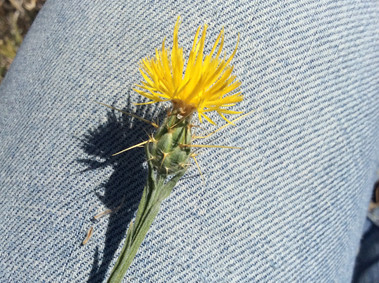Yellow Starthistle
- Jen Haynes

- Nov 6, 2021
- 2 min read
Yellow starthistle (Centaurea solstitialis) is a winter annual that is native to the Mediterranean. Yellow starthistle is in the same family as knapweed. It was introduced into the United States in the 1800s. There are currently no known infestations in B.C., but it has been found in Montana, Idaho, and Washington as well as many other U.S. states. There is an infestation about 20 km south of Osoyoos in Okanogan County and there are also infestations in Ferry County which is across the border from us in the Boundary. As part of the Weeds Cross Borders program, Ferry and Okanogan Counties work to keep yellow starthistle and other invasive plants from crossing into B.C. Yellow starthistle would do very well in many areas of the Boundary. It grows in dense infestations in dry grasslands, rangelands, pastures, roadsides, cropland, and disturbed areas. It reduces the availability of forage for wildlife and livestock. Partly because it is such a fast spreader, but it also may have an allelopathic effect on plants growing near it. It causes a fatal neurological disorder in horses called chewing disease. Symptoms of chewing disease are an inability to swallow, eat or drink and drowsiness. Yellow starthistle has a taproot. It grows up to 1 m tall. It has many branches. The branches have wings covered in fine hairs. The yellow flowers grow at the end of the branches. The flowers have sharp thorns that are up to 2 cm long. The plants start flowering around the end of June and continue to September. Yellow starthistle spreads solely by seed. A single plant usually produces about 1,000 seeds but in the right conditions a plant may produce up to 170,000 seeds. The seed remains viable in the soil for up to ten years. It has two types of seeds in each flower head. There are plumed seeds and plumeless seeds. Each type requires different conditions to germinate. If you suspect that you have seen yellow starthistle please report it to the Boundary Invasive Species Society. There are plenty of options for treating yellow starthistle but as this highly invasive, designated noxious plant is not yet know to be in BC it is important to discuss options with the BISS manager to make sure the plants are eradicated if they are found. The most important thing is to prevent the establishment of invasive plants though proper land management. Grazing practices, maintaining healthy plant communities, treating invasive species, monitoring your property for invasive plants, seeding disturbed areas and cleaning equipment before starting a job are just some of the things you can do to manage your property. For more information and to report invasive species please contact the Boundary Invasive Species Society 250-446-2446, info@boundaryinvasives.com, www.boundaryinvasives.com and Facebook.


















Comments